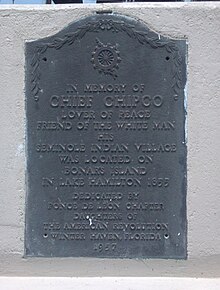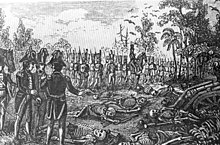Chipco
Chipco | |
|---|---|
 A memorial plaque to Chipco made by the Daughters of the American Revolution | |
| Nickname(s) | Echo Emathla |
| Born | Near Tallapoosa River, Alabama, United States of America |
| Died | October 16th, 1881 Lake Pierce, Florida, United States of America |
| Allegiance | Seminole |
| Years of service | 1835-1858 |
| Battles/wars |
|
Chipco, also known as Echo Emathla, was a 19th century Seminole chief and warrior. He was one of the most prominent Seminole chiefs during the Seminole Wars, and by the end of the conflict he was the main leader of the Muscogee-speaking Seminoles in Florida.[1] At a young age, Chipco and his family of Red Sticks fled as refugees to Florida because of the War of 1812, where they joined the Seminole tribe.[2] As Chipco grew older he became a chief and eventually fought against the United States and its policy of Indian removal. Chipco was one of the Seminole leaders at the Dade battle, where Seminole warriors successfully ambushed a column of the United States Army and killed over a 100 enemy soldiers.[1] This battle started the Second Seminole War, which Chipco would participate in through its entire duration. By the end of the Seminole Wars, Chipco and his band were part of the group of Seminoles who remained in Florida, and they were the only Seminole band who continued living in Central Florida.[3]
Biography[edit]
Chipco was born among the Upper Creeks of the Muscogee tribe who lived around the Tallapoosa River in Alabama. His family was part of the Red Sticks faction of the Muscogee. The Red Sticks were political traditionalists who opposed both the United States and the adoption of White American cultural practices. The Red Sticks were opposed by the "White Sticks" Muscogee faction, who advocated for allying with the United States and adopting White cultural practices such as chattel slavery, and were primarily made up of Lower Creeks. The Red Sticks were defeated by the United States and the White Sticks during the War of 1812, and many of them subsequently fled south as refugees to Florida. Chipco was part of this wave of refugees at a young age, and after migrating to Florida they soon joined the Seminole tribe who were already living in the area.[2]
During the First Seminole War in 1817, Chipco's father was killed by Andrew Jackson's troops at a Seminole village along the Suwannee River. His family then went further south and settled along the Peace River.[1] Chipco then moved near Tampa Bay, where he would start visiting the newly constructed Fort Brooke to trade.[2] Shortly before the Second Seminole War started, Chipco had risen to the position of chief among the Muscogee-speaking Seminoles. Around this time, President Andrew Jackson signed the Indian Removal Act, with the goal of ethnically cleansing the Seminoles from Florida. President Jackson also appointed Wiley Thompson, a former congressman from Georgia, to oversee the removal of the Florida Seminoles. Chipco and many other prominent Seminoles such as Abiaka and Osceola, staunchly opposed the Indian Removal policy.

Once it became clear that the Seminoles would not be removed without a fight, both sides made preparations for war. In December 1835, General Duncan Clinch ordered a column of US Army troops to march from Fort Brooke up north to Fort King in order to strengthen Fort King's defenses against an impending Seminole attack. This column was led by Major Francis Dade and was made up of 110 troops and 1 six-pounder cannon.[4] While marching north on December 28, 1835, the US soldiers were ambushed by a force of Seminole warriors, which included chief Chipco.[5] The Seminoles wiped out the army column and killed nearly all the soldiers, including Major Dade. This would subsequently be known as the Dade Battle, and it would mark the start of the Second Seminole War. Chipco fought all throughout the Second Seminole War, and he was never killed or captured. Chipco would employ guerrilla warfare tactics by staying hidden in the wilderness and constantly moving around.[3] Chipco's last known location during the Second Seminole War before hostilities ended in 1842 was Lake Istokpoga.[6]
While a temporary peace had been achieved in Florida with the end of the Second Seminole War in 1842, tensions between Seminoles and White Floridians still remained. In 1849 two White men named George Payne and Dempsey Whidden were killed by Seminoles at the Kennedy-Darling Trading Post by the Peace River, and the trading post itself was burned down. In 1850 a White orphan boy named Daniel Hubbard was also killed by Seminoles. Both of these killings were attributed to Chipco and his Seminole band.[6]
The US Government made one final attempt to remove the Seminoles from Florida in 1855, which began the Third Seminole War. Immediately after this war began, Chipco's band of Muscogee-speakers started to raid areas in both southern and central Florida. In 1856 the raiders from Chipco's band attacked Whites in Hendry County, Sarasota County, Hillsborough County, Pasco County, and Polk County.[7] After initially going on the offensive, Chipco and his band then went south to hide in the Everglades, where he successfully avoided capture for the remainder of the war.[8] In 1858 the Third Seminole War, and the Seminole Wars as a whole, ended as the United States decided to leave the remaining Seminole bands in Florida alone.

After the Seminole Wars ended, Chipco and his band left the Everglades and moved back up north to live in Central Florida.[8] Chipco's band subsequently set up a village near Lake Pierce in Polk County. Despite his great hostility towards the White Floridians during the Seminole Wars, Chipco ended up having friendly relations with the White settlers in his old age. He continued traveling to Tampa to trade, and he would dine at the homes of White settlers. In 1879, his village was visited by US Army officer Richard Henry Pratt. Pratt commented on how fertile the soil around the village was, and on the abundant amount of crops grown by Chipco's band. Pratt told Chipco that he had come to see what kind of help the government could give to his people, but Chipco dismissed any offers for help, saying he did not want to hear any "Washington talk".[9] Shortly before his death, Chipco chose his nephew Tallahassee to be his successor as the leader of the Muscogee-speaking band of Seminoles. Chipco died at his Lake Pierce village on October 16, 1881. His death was reported in many newspapers across the United States.[1]
References[edit]
- ^ a b c d Hannel, Eric (2024-03-01). "Amnesia, Anamnesis, and Myth-Making in Florida: A Case Study of Chipco". Florida Historical Quarterly. 98 (2).
- ^ a b c "Chipco And Tallahassee Led Seminole Remnant In Florida". freepages.rootsweb.com. Retrieved 2024-04-02.
- ^ a b Davidsson, Bob (2020-12-20). "Historians document Seminole Tribe of Florida's legacy". South Central Florida Life. Retrieved 2024-04-02.
- ^ "A Massacre of U.S. Soldiers Started the Second Seminole War - Warfare History Network". 2022-12-04. Archived from the original on 2022-12-04. Retrieved 2024-04-02.
- ^ Upham, Samuel C. (2024-01-16). Florida: Past and Present, Together with Notes from Sunland, on the Manate River, Gulf Coast of South Florida: Its Climate, Soil and Productions. BoD – Books on Demand. ISBN 978-3-385-31546-4.
- ^ a b Covington, James W. (2017-11-29). The Seminoles of Florida. University Press of Florida. ISBN 978-1-947372-37-5.
- ^ Covington, James (2021-05-06). "An Episode in the Third Seminole War". Florida Historical Quarterly. 45 (1).
- ^ a b Covington, James Warren (1982). The Billy Bowlegs War, 1855-1858: The Final Stand of the Seminoles Against the Whites. Mickler House Publishers. ISBN 978-0-913122-06-8.
- ^ "Article clipped from The Tampa Tribune". The Tampa Tribune. 1990-07-29. p. 120. Retrieved 2024-04-02.


 French
French Deutsch
Deutsch